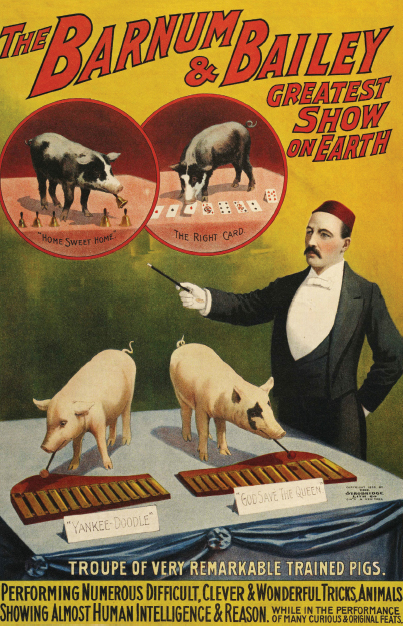P. T. Barnum and Buffalo Bill

Originally called “P. T. Barnum’s Great Traveling Museum, Menagerie, Caravan, and Hippodrome,” Barnum’s circus merged with Bailey’s circus in 1881 and again with the Ringling Bros. in 1919. Even with the ups and downs of the Ringling Bros. and Barnum & Bailey Circus over the decades, Barnum’s original catchphrase, “The Greatest Show on Earth,” endures to this day.
The most notorious press agent of the 1800s was Phineas Taylor (P. T.) Barnum, who used gross exaggeration, fraudulent stories, and staged events to secure newspaper coverage for his clients; his American Museum; and, later, his circus. Barnum’s circus, dubbed “The Greatest Show on Earth,” included the “midget” General Tom Thumb, Swedish soprano Jenny Lind, Jumbo the Elephant, and Joice Heth (who Barnum claimed was the 161-year-old nurse of George Washington, but who was actually eighty when she died). These performers became some of the earliest nationally known celebrities because of Barnum’s skill in using the media for promotion. Decrying outright fraud and cheating, Barnum understood that his audiences liked to be tricked. In newspapers and on handbills, he later often revealed the strategies behind his more elaborate hoaxes.
From 1883 to 1916, William F. Cody, who once killed buffalo for the railroads, promoted himself and his traveling show: “Buffalo Bill’s Wild West and Congress of Rough Riders of the World.” Cody’s troupe—which featured bedouins, Cossacks, and gauchos, as well as “cowboys and Indians”—re-created dramatic gunfights, the Civil War, and battles of the Old West. The show employed sharpshooter Annie Oakley and Lakota medicine man Sitting Bull, whose legends were partially shaped by Cody’s nine press agents. These agents were led by John Burke, who successfully promoted the show for its entire thirty-four-year run. Burke was one of the first press agents to use a wide variety of media channels to generate publicity: promotional newspaper stories, magazine articles and ads, dime novels, theater marquees, poster art, and early films. Burke and Buffalo Bill shaped many of the lasting myths about rugged American individualism and frontier expansion that were later adopted by books, radio programs, and Hollywood films about the American West. Along with Barnum, they were among the first to use publicity—a type of PR communication that uses various media messages to spread information about a person, a corporation, an issue, or a policy—to elevate entertainment culture to an international level.